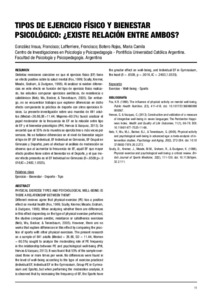Por favor, use este identificador para citar o enlazar este ítem:
https://repositorio.uca.edu.ar/handle/123456789/15108| Título: | Tipos de ejercicio físico y bienestar psicológico ¿Existe relación entre ambos? Physical exercise types and psychological well-being: Is there a relationship between them? |
Autor: | González Insúa, Francisco Lafferrière, Francisco Botero Rojas, Camila María |
Palabras clave: | EJERCICIO FISICO; BIENESTAR PSICOLOGICO; DEPORTES | Fecha de publicación: | 2018 | Editorial: | Universidad de Buenos Aires. Facultad de Psicología | Cita: | González Insua, F., Lafferriere, F., Botero Rojas, C.M. Tipos de ejercicio físico y bienestar psicológico ¿Existe relación entre ambos? [en línea]. Memorias X Congreso Internacional de Investigación y Práctica Profesional en Psicología XXV Jornadas de Investigación XIV Encuentro de Investigadores en Psicología del MERCOSUR. 2018. Buenos Aires: Universidad de Buenos Aires. Facultad de Psicología, 2018 Disponible en: https://repositorio.uca.edu.ar/handle/123456789/15108 | Resumen: | Resumen: Distintas revisiones coinciden en que el ejercicio físico (EF) tiene
un efecto positivo sobre la salud mental (Fox, 1999; Scully, Kremer,
Meade, Graham, & Dudgeon, 1998). Al analizar si existen diferencias
en este efecto en función del tipo de ejercicio físico realizado,
los estudios comparan ejercicios aeróbicos, de resistencia o
calisténicos (Netz, Wu, Becker, & Tenenbaum, 2005). Sin embargo,
no se encuentran trabajos que exploren diferencias en dicho
efecto comparando la práctica de deporte con otros ejercicios físicos.
La presente investigación sobre una muestra de 841 adultos
(Medad=26.86,DE=11.44; Mujeres=60.5%) buscó analizar el
papel moderador de la frecuencia de EF en la relación entre tipo
de EF y el bienestar-psicológico (PHI, Hervas & Vazquez, 2013). Se
encontró que el 55% de la muestra se ejercita tres o más veces por
semana. No se hallaron diferencias en el nivel de bienestar según
el tipo de EF (EF Individual, EF Individual en Gimnasio, EF Grupal en
Gimnasio y Deporte), pero al efectuar el análisis de moderación se
observa que al aumentar la frecuencia de EF, aquél EF que mayor
efecto positivo tiene sobre el bienestar es el Deporte, y el que menor
efecto presenta es el EF Individual en Gimnasio (ß=.6509;p=.0
016;IC=.2483,1.0535). Abstract: Different reviews agree that physical-exercise (PE) has a positive effect on mental health (Fox, 1999, Scully, Kremer, Meade, Graham, & Dudgeon, 1998). When analyzing whether there are differences in this effect depending on the type of physical exercise performed, the studies compare aerobic, resistance or calisthenics exercises (Netz, Wu, Becker, & Tenenbaum, 2005). However, there are no works that explore differences in this effect by comparing the practice of sports with other physical exercises. The present research on a sample of 841 adults (Medad = 26.86, SD = 11.44, Women = 60.5%) sought to analyze the moderating role of PE frequency in the relationship between PE and psychological well-being (PHI, Hervas & Vazquez, 2013). It was found that 55% of the sample exercised three or more times per week. No differences were found in the level of well-being according to the type of exercise practiced (Individual EF, Individual EF in the Gymnasium, Group PE in Gymnasium and Sports), but when performing the moderation analysis, it is observed that by increasing the frequency of EF, the Sports ha the greater effect on well-being, and Individual EF in Gymnasium, the least (ß = .6509, p = .0016, IC = .2483,1.0535). |
URI: | https://repositorio.uca.edu.ar/handle/123456789/15108 | ISSN: | 2618-2238 (online) 1667-6750 |
Disciplina: | PSICOLOGIA | Derechos: | Acceso abierto | Fuente: | Memorias X Congreso Internacional de Investigación y Práctica Profesional en Psicología XXV Jornadas de Investigación XIV Encuentro de Investigadores en Psicología del MERCOSUR. 2018. Buenos Aires: Universidad de Buenos Aires. Facultad de Psicología, 2018 |
| Aparece en las colecciones: | Ponencias |
Ficheros en este ítem:
| Fichero | Descripción | Tamaño | Formato | |
|---|---|---|---|---|
| tipos-ejercio-fisico.pdf | 42,75 kB | Adobe PDF |  Visualizar/Abrir |
Visualizaciones de página(s)
111
comprobado en 27-abr-2024
Descarga(s)
49
comprobado en 27-abr-2024
Google ScholarTM
Ver en Google Scholar
Este ítem está sujeto a una Licencia Creative Commons

